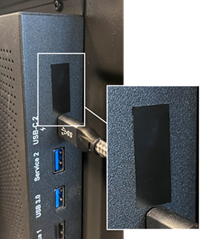Connecting other devices
In addition to computers, you can connect the following devices to the display:
USB drives, peripherals, and other devices
External displays
External audio systems
Room control systems
Warning
Ensure that any cables that cross the floor to the display are properly bundled and marked to avoid a trip hazard.
Depending on the model, the display includes either one USB Type-C receptacle and one USB 3.0 Type-A receptacle on the convenience panel, or two USB 3.0 Type-A receptacles on the convenience panel (see images below). The SMART Board 6000S (V3) models also include a USB Type-C receptacle on the connector panel. All models include one USB 3.0 Type-A receptacle on the connector panel.
You can connect USB drives, peripherals (such as keyboards), and other devices to these connectors and use the devices with the iQ experience, connected computers, and devices installed in the accessory slot, such as the SMART OPS PC.

SMART Board 6000S (V3)

SMART Board 6000S (C)

SMART Board 6000S
This feature is available only on the SMART Board 6000S (V3) and SMART Board 6000S (V3) Pro models.
Use a Micro-SD card to increase the display’s internal storage capacity. The Micro-SD card’s storage is combined with the internal storage of the display so you can save additional files, media, and apps on the display.
Important
Displays must have iQ system software 3.14 or later installed to use this feature.
SMART recommends a name brand Micro–SD card that has the following specifications:
SDHC or SDXC flash memory
Up to 80MB/s transfer speed
U1 or higher UHS speed class
C10 or higher video speed class
Single partition
To increase the display’s storage capacity
Insert an unformatted Micro-SD card into the SD card slot on the display.
The display detects the inserted SD card, formats it automatically, and makes it available as part of the display's internal storage capacity.
Note
The display might have a label covering the SD card slot. Remove this label to access the slot.

Verify that the SD card was successfully added by navigating to Settings
About
Internal Storage. The internal storage displays the added amount from the SD card.
Example
64GB (32GB internal + 32GB SD card)
Keep the SD card inserted in the display.
Note
If the SD card is removed, the display might not turn on or there may be lost data, including files and apps. To recover, reinsert the SD card or perform a factory reset.
You can connect an external display using the HDMI 2.0 out connector on the connector panel (pictured). The external display will show the same image. This is useful when you’re using the display in an auditorium or other large space where it would be beneficial to have a second display.

SMART Board 6000S (V3)

SMART Board 6000S and 6000S (C)
Important
If the connected external display doesn’t support HDCP, the image on the external display is limited to 480p resolution. For full resolution output, connect a display that supports HDCP.
The display includes two speakers, which are designed to provide sound at the front of a room. You might want to connect an external audio system if you’re providing sound in a larger space.
You can connect the display to an external audio system using the stereo 3.5 mm out connector (pictured). This disables the display’s internal speakers. Alternatively, you can connect an external audio system directly to a room computer.

SMART Board 6000S (V3)

SMART Board 6000S and 6000S (C)
In addition, the display provides a Sony/Philips Digital Interface (S/PDIF) out connector (pictured). S/PDIF is a digital audio transmission medium. You need an audio system that has an S/PDIF input to decode this connection to analog. Most external sound bars include a S/PDIF connector.

SMART Board 6000S (V3)

SMART Board 6000S and 6000S (C)
Notes
If you connect an external speaker system to the display using the Sony/Philips Digital Interface (S/PDIF) out connector and the audio source device is connected to the display using an HDMI 2.0 connection, the external speaker system must support HDCP 2.2. For more information, see SMART Board interactive flat panels and High-bandwidth Digital Content Protection (HDCP).
The S/PDIF audio is a fixed-volume output. Adjusting the display’s volume for its internal speakers does not affect the volume output of the S/PDIF port.
A room control system enables users to control a room’s lighting, audio system, and possibly, the display. Some installations may require you to integrate the display with a room control system.
You can use the display’s RS-232 connector to connect a third-party external control system to the display (see Managing SMART Board 6000S (C) or 6000S series displays using RS‑232 or Managing your SMART Board 6000S (V3) display using RS-232).
Note
Displays are not compatible with centralized remote control systems, such as a universal remote control.